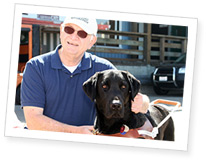Text Size:


Vision and Guide Dogs
By Nancy E. S. Gardner

As our general population ages, the number of people losing their sight in later life due to degenerative diseases is increasing. Common degenerative diseases include: age-related macular degeneration, glaucoma, diabetic retinopathy, and cataracts (see http://lighthouse.org/livingbetter/common-age/).
Often, when someone begins to lose their vision, they may discover their quality of life diminishing. They may feel less willing or able to get out and about independently, and may fear for their safety when stepping off curbs or crossing streets.
Adjusting to vision loss can be challenging, but there are many resources available. Lighthouse International (http://lighthouse.org) and the American Foundation for the Blind are just two examples (http://afb.org.)
Usually, someone experiencing difficulty in traveling safely and independently will receive “orientation and mobility” training from a professional. Once they have received this training, they may also consider the option of getting a guide dog.
A guide dog can inspire enhanced independence and confidence. In addition to safe travel, the dogs offer companionship and are often a social magnet. Because the dogs are specifically trained to assist someone with their mobility, they are allowed on public transportation, in stores and restaurants, and everywhere the public is allowed.
A person who is legally blind, with no or low vision should answer the following questions when considering a guide dog:
- Using a mobility aid, do you walk to destinations by yourself in your home area? If not, do you want to? Are there places to which you would like to travel, but are uncomfortable doing so or feel unsafe?
- Are you able to comfortably walk a distance of roughly one mile, on a daily basis, during the training period? If not, are you willing to develop the stamina and ability to walk this distance? If you need to take a short rest during a walk of this length, you may still benefit from having a guide dog.
- If you have a degree of functional vision, do you feel a desire to increase your present level of independence? Do you feel that you can trust a dog to guide you while you use your functional vision for orientation?
- Are those who live with you comfortable about having a dog in the home and are they willing to learn and comply with some basic rules of conduct regarding the care, control and behavior of your dog? What about your co-workers?
- Would you enjoy having more contact with the public? Do you like the idea of having a pet in your home when your dog is off duty?
- For more information, please visit http:www.guidedogs.com or call 800 295-4050.

Nancy E. S. Gardner is CEO and President of Guide Dogs for the Blind. She has dedicated most of her career to the developmental disability field in California and Kansas and spent several years as a Chief Consultant to the California Assembly Ways and Means Committee overseeing the Departments of Social Services, Mental Health, Developmental Services, Rehabilitation and Aging.
Visit Guide Dogs for the Blind at www.guidedogs.com where powerful life-long partnerships are created between skilled mobility dogs and people who are blind or visually impaired throughout the United States and Canada. All services are provided free-of-charge.
More...